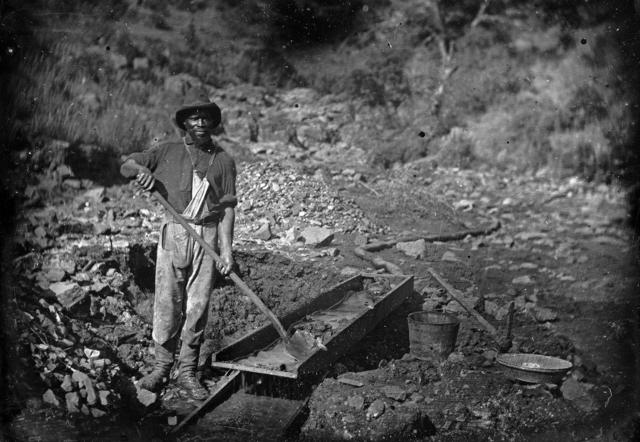California Slaves

Remember, when we talk about slavery in this nation, we need to center California as a major slave state.
San Bernardino’s early success rested on a pair of seemingly incongruous forces: Mormonism and slavery.
In 1851, some 450 Latter-day Saints — Mormons — were sent by their church from Utah to establish a colony in what we call the Inland Empire. Within several years, the settlement’s population skyrocketed to more than 3,000 — at least as big as, if not bigger, than Los Angeles.
The pioneers plotted a town, established a municipal government and created the separate County of San Bernardino. To transform arid land into a thriving agricultural settlement, the Saints exploited dozens of enslaved African Americans that they had brought with them from Utah, as well as an untold number of coerced Native American laborers.
Slaveholders occupied the upper echelons of the Mormon hierarchy in San Bernardino. According to U.S. census data and the records of the Church of Jesus Christ of Latter-day Saints, the colony’s co-founder and its bishop owned slaves. One of San Bernardino’s high counselors, Robert Mays Smith, did too. In fact, Smith claimed 14 enslaved women and children, making him the largest slaveholder in the continent’s Far West.
Although most Mormons hailed from free states, the leadership of the LDS Church welcomed slaveholding converts in the 1840s and ’50s. Slaveholders were among the first settlers in what would become the territory of Utah, which was organized in 1850. In 1852, the Mormon-dominated territorial legislature passed a law innocuously called “An Act in Relation to Service.” With the measure, Utah became the first Far Western territory to legalize African American slavery.
When Mormon slaveholders crossed the border into California, they entered a free state. California’s Constitution of 1850 outlawed slavery, but its Legislature and courts, dominated by migrants from the South, defended coercive labor practices in the state. Well into the 1850s, the slaveholders of San Bernardino operated openly, free from legal interference.
To supplement their African American workforce, Mormons purchased and “adopted” Indian children. By the early 1850s, both California and Utah had legalized Native American servitude. “An Act for the Relief of Indian Slaves and Prisoners” allowed Utah’s white residents to keep Native children in their households for up to 20 years. Those children were generally required to work to pay back the price of their own purchase. Through a similar law, white Californians secured Indian minors as domestic wards.
African Americans and Native Americans occupied the lowest rungs of a strict social and political hierarchy in San Bernardino. According to LDS custom, church leaders exercised a monopoly on religious and civil offices alike. All San Bernardino County officials were Mormons.
The LDS colonists’ stable and well-regulated government contrasted sharply with that of neighboring Los Angeles. Between 1850 and 1859, according to Yale historian John Mack Faragher, L.A. County witnessed 200 homicides out of a total population of several thousand. Few if any American cities had a higher murder rate. From that standpoint, California’s first “broken city” was Los Angeles, not San Bernardino.
Antebellum San Bernardino rose rapidly, but it fell even faster. The source of the town’s stability — its Mormon hierarchy — became its greatest liability. By the mid-1850s, chafing under the authority of the LDS Church, disaffected Saints and non-Mormons challenged the colony’s leaders. When the settlement’s co-founders — its kingpins — threatened to seize land without compensation, opposition intensified. Brigham Young, dismayed by the unrest, recalled the faithful to Utah in 1857. Within a year, 1,400 Mormons left California.
Church authority and the institution of slavery in San Bernardino unraveled simultaneously. Robert Mays Smith was among the dissenters. When he attempted to leave for Texas with his slaves in late 1855, he was served with a writ of habeas corpus. The court required him to establish that he had a right to remove his bondspeople from the state. He fled instead of appearing in court, and 14 African American women and children finally walked free, six years after California technically outlawed slavery.
One former Smith slave, Biddy Mason, moved to L.A., where she became a nurse, a real estate investor, a religious leader and a philanthropist. She tended to prisoners and orphans, funded L.A.’s first elementary school for black children and co-founded its first African American church. As the city boomed in the late 19th century, so too did her fortune. When she died in 1891, Mason was worth an estimated $300,000 (roughly $8.5 million today). In many ways, her remarkable life mirrored the shift in opportunity and wealth from San Bernardino to Los Angeles.
This is just one story of slavery in California. There was plenty of slavery in California–well after 1865. This was the era when slave raiding parties devastated the small tribes of northern California and engaged in massive forced labor campaigns that finally forced the government to intervene and remind the people of the Golden State that the 13th Amendment didn’t only apply to black people.


